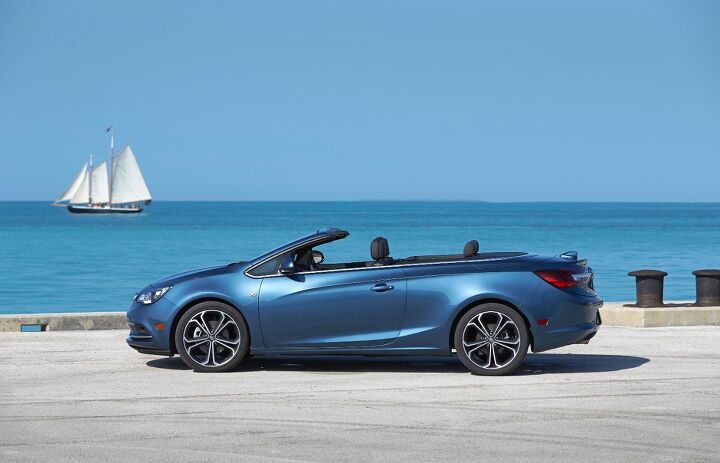Bye, Bye, Buick: A German-American Convertible Prepares to Exit the Stage

Everyone knew this was coming, but now it’s official. The current model year will be the Buick Cascada’s last.
Hitting dealer (and rental) lots in the U.S. at the dawn of 2016, the Opel-built drop top motivated its two-ton weight with a turbocharged 1.6-liter four-cylinder — an engine that gave away the model’s European heritage. With Opel no longer in the hands of General Motors, Americans stand to lose another model that, while perhaps not hugely desirable, is at least interesting and different.
Word of the Cascada’s discontinuation date comes via Automotive News, which cites GM’s plan to end production over the summer. Dealers have been told to make their final order. Thus, the 2019 Cascada will be the last Cascada.
Now owned by France’s PSA Group, Opel announced plans last fall to cease production of three car models, including the Cascada. The convertible-only model calls Poland home and is sold by various marques, depending on market. Britain’s Vauxhall has its own Cascada, as does Australia’s Holden brand.
Buick, soon to be left with only a single passenger car, touted the Cascada’s ability to draw new buyers into the brand.
“The Cascada has played its role in the portfolio perfectly, outselling many other premium convertibles while bringing in [six of every 10] buyers from outside GM,” the brand said in a statement to Automotive News. “However, it has reached the end of its originally-planned lifecycle and 2019 will be the last model year offered. Dealers have been notified and many will have stock through the rest of this year.”
While debate raged smoldered over the past few years as to the Cascada’s attributes, the car did fill a role in sunny climes, what with the demise of the Chrysler Sebring/200 convertible. The car’s sales told the story, however. Its first year on the U.S. market proved to be its best, with volume falling off in each subsequent year. Only one month saw the Cascada top 1,000 units (April 2016). The Cascada’s fourth-quarter 2018 sales totalled just 743 vehicles — a 26.1 percent decline from Q4 2017.
With the Cascada’s death, America loses not only its last two-door Buick, but also its last “domestic” non-sports car convertible (of the car variety, that is). Those seeking a roomy whip for sedate boulevard cruising had best call up the Germans.
[Images: General Motors]

More by Steph Willems
Latest Car Reviews
Read moreLatest Product Reviews
Read moreRecent Comments
- MaintenanceCosts I already set out total costs, so this time I'll list what's had to be done on my cars (not counting oil changes, recall, or free services):2019 Bolt (25k mi): new 12v battery, pending tires & battery cooling service2016 Highlander (from 43k to 69k mi): new front rotors, new pads all around, new PCV valve, 2x 12v batteries, light bulbs, pending tires2011 335i (from 89k to 91k): new valve cover gasket, new spark plugs, light bulbs, pending rear main seal1995 Legend (from 185k to 203k): timing belt/water pump, new EGR valve + pipe, struts, strut bushings, drive axles, tie rods, rear control arms, other suspension bushings, coolant hose & brake lines throughout, belts, radiator, valve cover gaskets, new power antenna, 12v battery, coils, spark plugs, tires, rear pads... it's an old car!
- VoGhost Consistent with CR's data. I've spent about $150 total on the Model 3 in six years of ownership, outside of tires.
- VoGhost It's just plain sad that Posky doesn't know that EV batteries are warrantied for 8 years / 100K miles.
- Jkross22 It used to be depreciation was the most expensive part of car ownership. Seems like those days are over (New EVs and lux cars excluded). Maintenance + insurance have taken over. Dealerships offering 2 years of maintenance means nothing. That's $200 tops. It's the unexpected repairs - a wiring harness, computer module, heater core, AWD problems - that will cost dearly. Brakes can be expensive since many cars now can't have rotors resurfaced. Even independents are charging a lot for this work.
- FreedMike VW tossed in two years' maintenance on my car, and the next one's due after the lease is up. But all the car's needed has been oil changes and tire rotations. Unfortunately, the OEM tires (Hankook Kinergy) were unrepentant trash and needed to be replaced at around 23,000 miles. So...my maintenance cost over over a little under three years has been t $800 for the new tires. That sucks, but the new tires (Goodyear Eagle Sport) are a massive upgrade over the Hankooks. Ah well.



































Comments
Join the conversation
Apparently, PSA has turned Opel around in just a year's time. This is something GM management simply could not do. This perfectly illustrates that GM management simply is not effective. The article below also claims wall street and its stockholders give GM little flexibility. How long will it be until PSA drops GM to fifth place in international sales. Remember, people never thought Nissan will surpass GM in global sales. https://europe.autonews.com/article/20180829/ANE/180829754/how-psa-turned-around-opel-gm-s-german-castoff
Look, I love a relaxed fit convertible. I had a '93 Cutlass and before that an '86 Aries. Sometimes you just want a nice four seater convertible with a useable back seat and trunk, a segment nicely filled at one point by the Solara/LeBaron/Sebring. The Camaro is too silly, the Germans are too expensive/fragile/cramped, and the Mustang is too small. The Cascada had the Opel build against it (I had a Catera, so nope) then it had no useable back seat and it was ugly inside with cheap, ugly black plastics. GM hasn't built a car I would be remotely interested in buying in years and doesn't seem likely to.